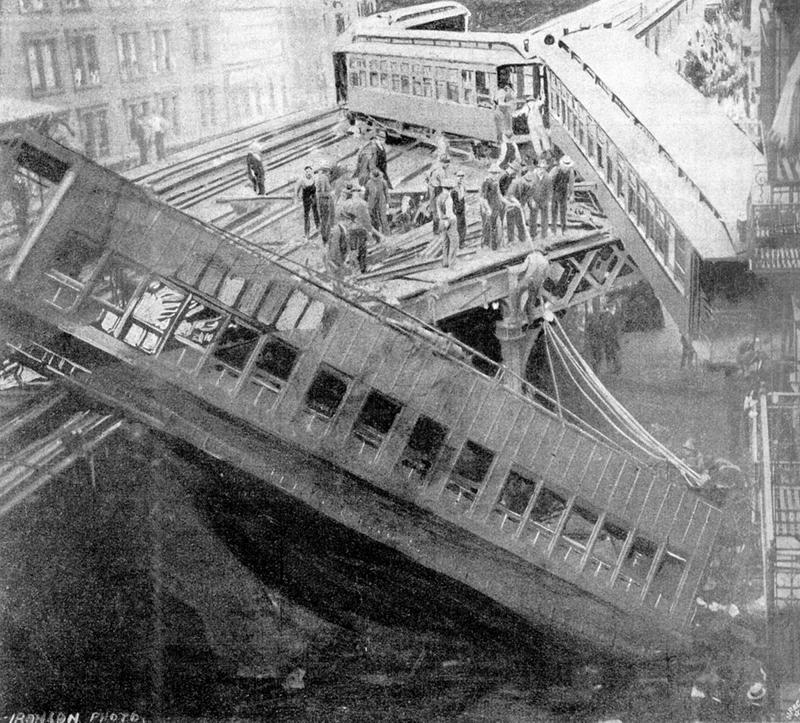Most Deadly Train Wrecks in History
By | September 19, 2018

This crash took place during the morning rush hour on September 11, 1905 at Ninth Avenue, which is only 35 minutes away from the location of the twin towers. This derailment was one of the worst accidents in the history of the New York City railways, resulting in 13 deaths and 48 serious injuries.
The 9th Avenue train that was following the 6th Avenue train was switched by mistake to go to the curve instead of going straight. Rather than going 9 mph, as it should have been, it was going 30 mph when it got to the curve. The motorman braked, which enabled the lead car to stay on the track, but the second car was thrown off and into the street, with one end on the ground and the other across the third rail on the trestle. An electrical fire started and the roof was ripped off; a falling truck, along with some motor equipment from the third car, came crashing down on passengers crushing them beneath the car. The third car, along with the fallen truck, came to a stop and ended up hanging off the edge of the trestle up against the front of an apartment complex.
It was determined that the train operator was at fault, but he disappeared after the accident. He was eventually found and arrested two years later and two years after that, he and another inmate escaped from Sing Sing prison but was recaptured.

The victims who died either drowned or died of fire and/or smoke inhalation as the fuel tanks, holding several thousand gallons, ruptured on impact. The wreck would have been avoided if it wasn’t for a 30 minute delay in New Orleans to repair an air conditioner unit and a toilet. They would have crossed over the bridge safely before the collision happened with the barges. It was the deadliest train wreck in the history of Amtrak.

The Railway accident that happened in Newark Bay was considered to be worse than the Amtrak wreck, which occurred on September 15, 1958. Again, like the Amtrak wreck, it happened in the morning when the commuter train ran through a stop signal causing the train to derail and slide off the open lift bridge. The first two coaches, along with both diesel locomotives drove right into the bay and sank, with 48 people losing their lives (including the engineer) and 48 people being injured.
Hanging off the lift bridge was a third coach that hung there for two hours before falling into the water. One cause was determined to be the absence of a “dead man’s control” which was installed on all passenger locomotives per New Jersey Public Utilities Commission after this incident occurred. This device is activated if the human operator becomes incapacitated for any reason. The reason this train did not already have the device installed was because they had two crewman in the cab and it was assumed that if the engineer became incapacitated, the fireman could control the train, which he apparently did not do. The autopsy of the engineer indicated that he had hypertensive heart disease but he died of asphyxia from drowning. There were no defects found in the braking system or the signals and derailing devices.

The most tragic subway accident in New York happened on November 1, 1918 where 92 people lost their lives and 100 others were injured. The train, entering the tunnel to Prospect Park, was trying to negotiate a curve, that should have been taken at a speed of 6 mph, not 30-40 mph. With the first car having derailed, the other two right behind it went completely off the tracks, ripping off the left-hand sides and roofs. The subway operator, not being injured, left the scene.
A causative factor was that the BLE (Brotherhood of Locomotive Engineers), went on strike that morning, leaving a shortage of operators. The motorman that day, Edward Luciano, was a crew dispatcher, having never operated a train with passengers before. His only experience was moving non-revenue trains in a train yard. He only had two hours of the required sixty hours of training before operating the revenue-generating train. Later, Luciano claimed he had attempted to slow the train but evidence showed differently -- that there was no attempt to even apply the brake, after passing multiple stations. He was suffering from insomnia due to the loss of his child and he was working a double shift that day. The case was brought to trial for manslaughter by the mayor but no conviction was handed down.

New Jersey Transit train that hurtled past its stopping point at the Hoboken station on September 29, 2016, brought yet another morning rush hour crash – only one person died but 114 were injured, including the train operator. The train failed to stop as it was traveling into the station, going over bumping posts and hitting the wall of the terminal.
When questioned after the train accident, he said he had no memory of the crash and was later diagnosed with sleep apnea. There was no PTC on the train, a device that kicks in when needed to control the speed of the train.

